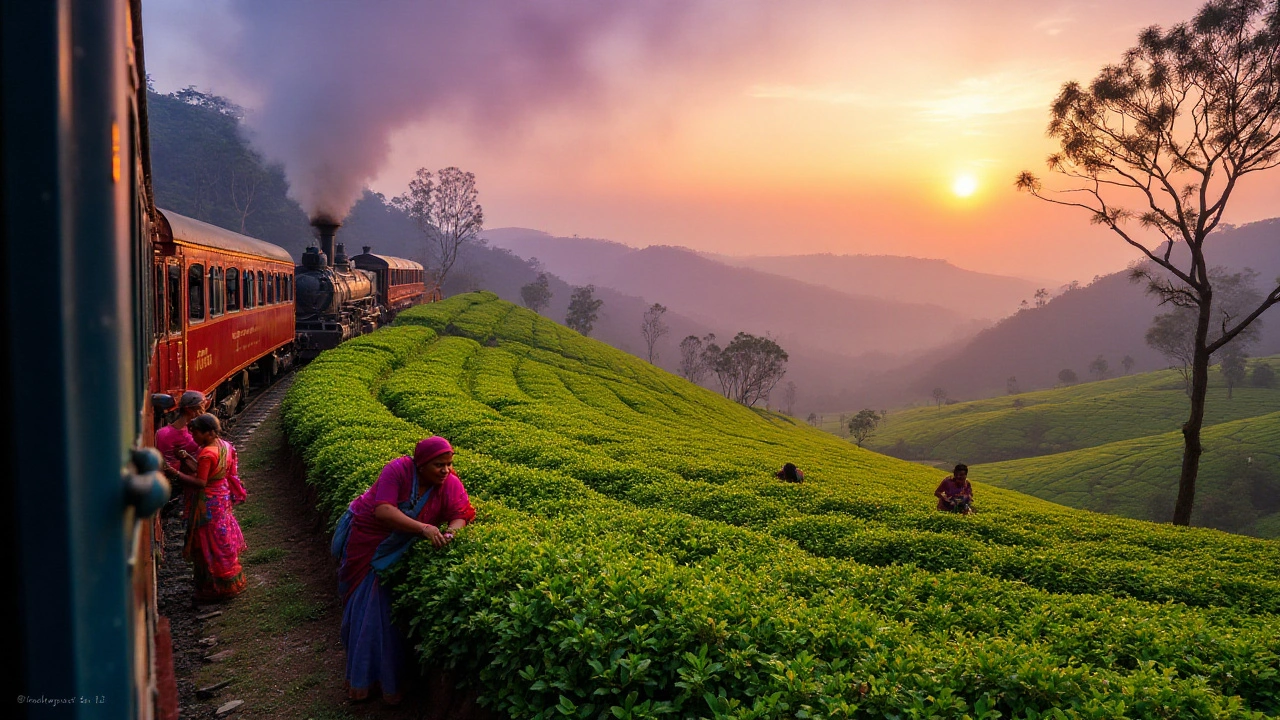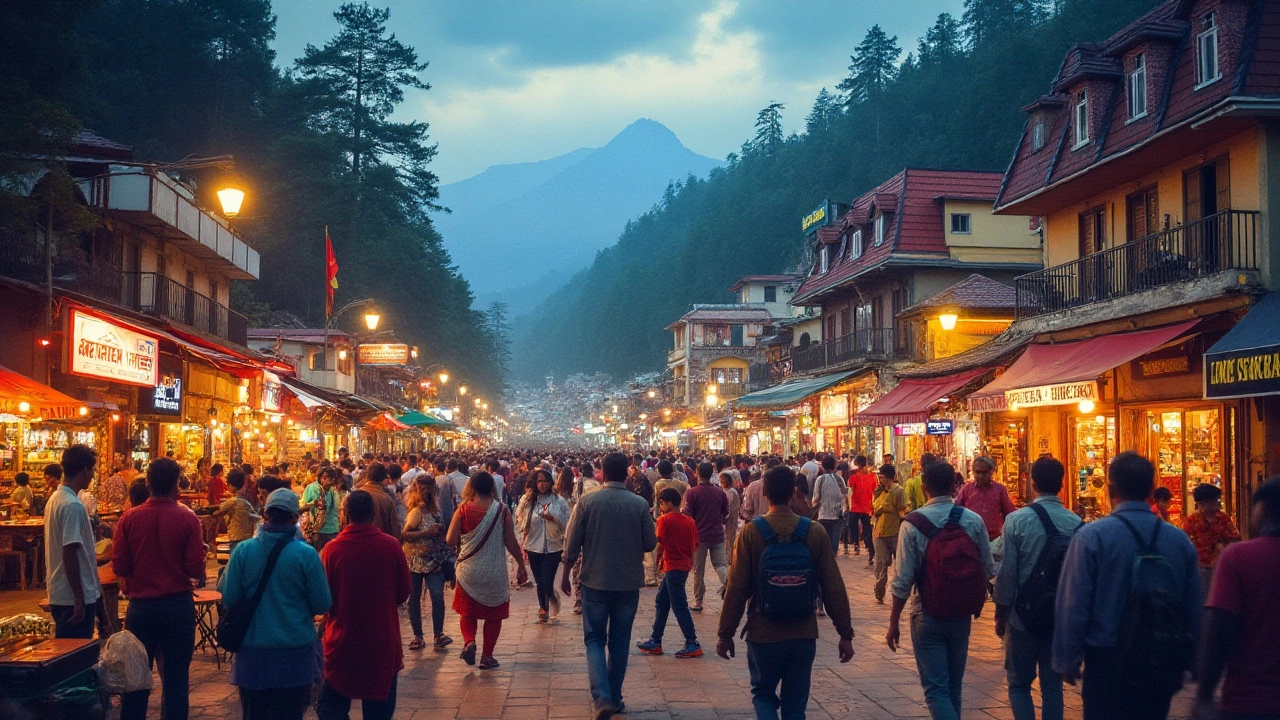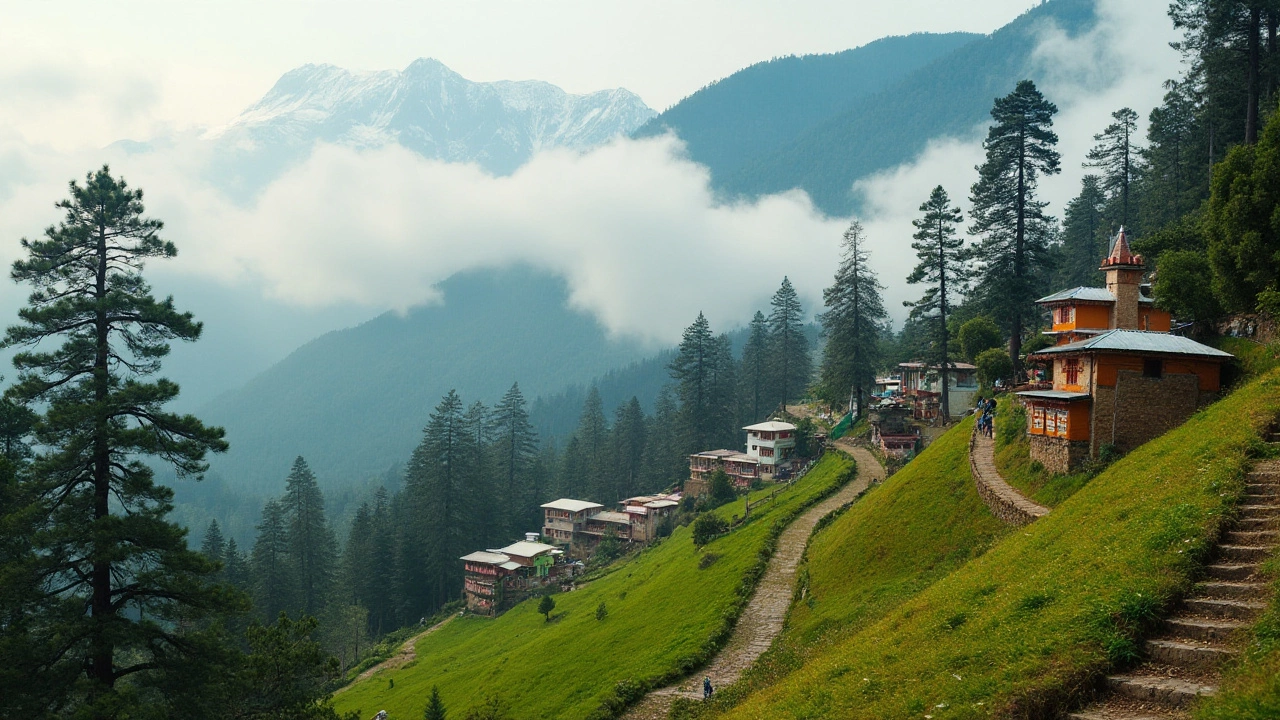India's vast landscapes offer a magnificent array of hill stations, each as captivating and unique as the next. These elevated retreats provide solace from the bustling cities and sweltering heat, drawing tourists and locals alike toward their refreshing climes and breathtaking vistas. While many states boast these elevated escapes, one state leads the pack with a delightful abundance of hill stations.
From seeking adventure in the rugged terrains to simply basking in the serene beauty of mist-laden mountains, hill stations cater to every kind of traveler. As you journey across different regions, you'll encounter a tapestry of cultural experiences and natural wonders that make each visit memorable. Whether it's the cool, crisp air or the scent of pine that invites you, these hills have a story to tell and secrets to share with those willing to listen.
- State with the Most Hill Stations
- Notable Hill Stations to Visit
- Activities and Attractions
- Climate and Best Travel Seasons
- Travel Tips for Hill Station Adventures
State with the Most Hill Stations
When it comes to the number of hill stations, Himachal Pradesh is often celebrated as the crown jewel. Nestled in the lap of the Himalayas, this state boasts a landscape that's not only picturesque but also steeped in charm and mystery. With an abundance of hills, valleys, and rivers, Himachal Pradesh offers more than just a visual feast; it is a haven for those seeking tranquility and adventure alike. In this mountainous state, the hills are not merely geography; they are an experience that lures travelers from across the globe.
Among the notable hill stations in Himachal Pradesh, Shimla stands out as the summer capital of British India, offering a blend of colonial history and natural beauty. The architectural splendor reflects its rich past while the surrounding deodar forests and snow-covered hills offer a refreshing escape. Not far behind in popularity is Manali, known for its breathtaking views and as a gateway to the Rohtang Pass and Solang Valley. These spots are not just destinations but journeys that take you deep into nature's marvels.
From Dalhousie with its Victorian charm to the sprawling tea gardens of Palampur, each station has a unique story. A surprising number of activities, from trekking and paragliding to simply enjoying a cozy retreat in a wooden cabin, allow every kind of traveler to find their calling. Unlike the bustling cities, the rhythm of life here is dictated by the chirping of birds and the flow of rivers. It's this serene pace of life that makes the hill stations in Himachal Pradesh uniquely compelling.
Intriguingly, Himachal Pradesh isn't just limited to known names. Many lesser-explored areas, such as Tirthan Valley and Chitkul, offer untouched beauty that invites exploration. Nature thrives uninhibited here, and while tourists have their favorites, a true adventurer knows that the lesser-known paths often hold the greatest treasures. The captivating culture and warm hospitality of the local communities add layers to the traveler’s experience.
"Visiting Himachal Pradesh is like diving into a grand, verdant ocean where every ripple leads to a new discovery," remarks a seasoned traveler in the Himalayan Guidebook.
Apart from Himachal Pradesh, Maharashtra also deserves mention due to its large number of hill stations. From Matheran with its toy trains to the splendid views from Mahabaleshwar, the state presents an intriguing contrast between bustling cosmopolitan cities and tranquil, windy mountain tops. Yet, it's Himachal, with its elevated expanse and sheer variety, that reigns supreme when counting these atmospheric refuges.
Notable Hill Stations to Visit
Set amidst the awe-inspiring landscapes of India, hill stations offer a retreat into the heart of nature where the airs are cool and the vistas expansive. When it comes to notable hill stations in India, the variety is as impressive as the geography itself. From North to South, each region holds its own charm. In the North, Himachal Pradesh is a name that stands tall with its array of scenic destinations. Manali, often referred to as the queen of hill stations, stands out with its lush valleys and awe-inspiring mountain peaks, not forgetting the vibrant town that caters to adventurers seeking both treks and tranquility. The Beas River enhances the charm as it flows gracefully, giving both peace and thrill to those indulging in river rafting.
The South also boasts exceptional hill stations, with Tamil Nadu offering the charming Ooty, nestled in the Nilgiris. Known for its exquisite tea gardens and majestic botanical gardens, Ooty captivates hearts with its unique blend of colonial architecture and natural splendor. An unforgettable journey on the toy train, which winds its way through breathtaking ridges and forests, offers a panorama that feels like a serene painting. Not far behind, Kerala offers Munnar, a paradise of verdant tea plantations and rolling hills. The aroma of cardamom and jasmine invites travelers into its cool, misty embrace, perfect for those desiring peace and a deeper connection with the calmness of nature.
In the West, Maharashtra is not to be left out, thanks to the mystical allure of Lonavala and Mahabaleshwar. These hill stations are not just about nature's bounty; they resonate with rich histories and tales. Lonavala’s Karla Caves are an enthralling adventure into ancient Buddhism, while Mahabaleshwar offers delightful strawberries and a chance to taste what is rightly called nature's candy. The experience at these sites is akin to walking through pages of history while being caressed by the fresh, mountain breezes.
“India is a land of myriad hill stations, each one offering a retreat away from the cacophony of daily life,” says the renowned travel writer, Sudha Mahalingam.
Every hill station carries its own soul and story, waiting to be discovered by keen travelers.With such vast options, it’s important for travelers to decide the type of adventure or solace they’re seeking. Be it cultural exploration, gastronomic delights, or just the silent whispers of nature, India’s hill stations deliver a bouquet of experiences.

Activities and Attractions
Hill stations in India offer a treasure trove of activities and attractions that promise an unforgettable experience for every type of traveler. From adrenaline junkies to peace seekers, there's something for everyone. These serene locations are perfect for trekking enthusiasts, offering trails that lead through lush forests, along rocky terrains, and to breathtaking views at every turn. For instance, Himachal Pradesh's Triund Trek is a popular choice among backpackers. The trek not only showcases the majestic Dhauladhar range but also allows you to immerse yourself in the tranquil surroundings of Dharamshala.
In addition to trekking, visitors can indulge in paragliding, which offers a bird's-eye view of the scenic beauty below. Destinations like Bir Billing in Himachal Pradesh, which is regarded as one of the best paragliding spots in the world, draw aerodynamics enthusiasts from across the globe. For those less inclined towards heights, the serene backwaters and lakes of hill stations like Nainital and Munnar offer boating excursions that are equally captivating. Floating amidst the Himalayan backdrop or amid the lush tea gardens of Kerala can provide a unique perspective on these idyllic locales.
Apart from the physical activities, hill stations are steeped in rich cultural heritage and history, reflected in the local architecture and traditional festivals. Strolling through the streets of Shimla or Darjeeling, you will encounter colonial-era buildings, vibrant bazaars, and an array of temples and monasteries that narrate tales from the past. A visit to the iconic Christ Church in Shimla or the enchanting Tibetan Monasteries of Sikkim is a feast for those who seek spiritual repose.
For wildlife lovers, the hill stations often act as gateways to bio-diverse sanctuaries and national parks. The Neora Valley National Park near Kalimpong is home to an array of flora and fauna, including the Red Panda. Birdwatchers, too, find paradise in these verdant settings, where vibrant avian life is an ever-present joy. Imagine waking up to the call of Himalayan monals or capturing a glimpse of the elusive black-necked crane amidst the tranquil landscapes.
"The hill stations of India are not merely destinations; they are experiences that touch the soul," writes travel expert Ritu Menon. "Each hill station has its own personality and elements that make it unique."
If you venture into Mysore's Coorg or Tamil Nadu's Nilgiris, don't miss the opportunity to explore the tea and coffee plantations. Here, you can learn about the journey from leaf to cup and relish the fresh flavors right at the source. The gently rolling hills of these fertile regions are perfectly set for leisurely strolls, providing not just scenic views but also insights into the thriving industries that sustain the local economy.
Every hill station in India has its unique set of attractions and activities, tailored to engage your senses and spirit. Whether your desire is to explore ancient trails, soar through the skies, or simply sip freshly brewed tea while overlooking a valley, these picturesque retreats await, ready to offer memories that last a lifetime. So pack your bags and set out on a journey to uncover the hidden treasures of India's mountains, where adventure and serenity live in harmony amidst the clouds.
Climate and Best Travel Seasons
India's hill stations, famed for their stunning landscapes and refreshing climate, vary significantly in their seasonal allure. These highland retreats are shaped by the complex interplay of geography and weather patterns. The Indian subcontinent's climatic diversity profoundly influences the best periods to visit these elevated wonders. The towering Himalayas in the north offer a chill that lasts well into late spring, while southern ranges like the Western Ghats cloak themselves in misty allure during the monsoon months. Understanding these climatic nuances can greatly enhance your travel experience, allowing you to choose a perfect time to explore the marvelous heights.
Visitors seeking the cool respite of India's northern hill stations, such as Shimla, Manali, and Srinagar, are greeted by snow-blanketed panoramas in winter. However, for comfortable trekking and sightseeing, the mild springs and fall seasons, between March to June and September to November respectively, present ideal conditions. In contrast, the eastern and southern ranges showcase their lush green vistas and cascades of waterfalls during the monsoon between June and September, making this time a captivating period for nature lovers, albeit requiring caution due to heavy rains.
The British colonial legacy has left behind a trail of picturesque and accessible hill stations throughout India, each with its climate charms. While in the Western Ghats, places like Munnar and Ooty offer cool escapades from the tropical heat almost year-round, the summer months between April and November shine as the peak tourist seasons. The Northeast Indian hill stations such as Shillong and Gangtok also possess a unique charm. They bloom in full glory during spring, drawing tourists to witness rare flora and the rhythmic cultural festivals that mark the year's change.
According to the India Meteorological Department, "Hill stations typically experience a temperature drop of about 10°C to 15°C compared to the lowlands, creating a microclimate conducive for year-round tourism."
Whether you are there for solitary peace, romantic excursions, or family holidays, being aware of the climate patterns helps finalize travel plans. It’s wise to check local forecasts regularly prior to and during your trip to anticipate any unusual weather swings. Some travelers often find the off-season offers significant advantages, such as fewer crowds and lower accommodation costs. In balance, knowing the prime times aids the creation of itineraries that embrace both personal interests and optimal weather conditions, ensuring memorable adventures in India's remarkable scenic destinations.

Travel Tips for Hill Station Adventures
Embarking on an adventure to any of India's majestic hill stations is an experience filled with enchanting scenery and a chance to dive into nature's embrace. Preparing well for such a journey amplifies the joy and minimizes unexpected hassles. First and foremost, checking the weather conditions is crucial, as the climate can shift significantly within these elevated realms. Cold nights might catch you off-guard, especially if you aren't equipped with adequate warm clothing. Dressing in layers is not only practical but also essential to tackle varying temperatures throughout the day. Sturdy walking shoes should top your packing list, given that many attractions require a fair bit of trekking or walking through rugged paths.
If you're traveling during peak tourist season, booking accommodations in advance is a wise decision to secure a comfy stay amidst the bustling demand. Hotels and lodges nestled within these natural wonders often offer quaint charm and splendid views, enhancing your overall experience. Nourishing one's body adequately is just as crucial, so snack wisely with energy-rich foods like nuts and dried fruits. Keeping hydrated with water and perhaps a thermos of hot tea during chilly excursions will keep your spirits high.
Packing Essentials and Health
While you pack, remember to include a kit with basic medications and first-aid supplies. Given the remote locations of some hill stations, medical facilities may not always be immediate, so having essentials like pain relievers, antiseptics, and adhesive bandages can prove invaluable. Altitude adjustments can occasionally lead to mild headaches or dizziness, making it essential to move at a comfortable pace and rest when needed. Another key tip is to respect the local environment and communities. These areas often thrive on tourism, so supporting local businesses and respecting preservation efforts helps maintain the charm and sustainability of these stunning locations.
For those planning a longer stay, researching local festivals or events can add a culturally enriching layer to your travel experience. Engaging with local traditions or food markets offers insights far deeper than what a casual tourist glimpse can provide. In the words of author Pico Iyer,
‘Travel is like love, mostly because it’s a heightened state of awareness, in which we are mindful, receptive, undimmed by familiarity and ready to be transformed.’This perspective beautifully encapsulates the mindset one could adopt for a genuinely transformative visit to these scenic escapes.
Budget and Itinerary Ideas
Budgeting effectively enriches your journey, ensuring you're ready for any spontaneous opportunities, like impromptu rafting tours or horseback rides that might catch your fancy. An itinerary affords a structured approach to discovering various renowned sites without missing out. However, allowing some flexibility for unplanned adventures can often lead to the most treasured memories. It's vital to recognize how short distances on maps might translate to lengthy travel times owing to winding mountain roads, so plan commutes with a buffer time. An added tip: having a local SIM card can ensure constant connectivity for GPS services and emergency communications.
A sprinkle of technological preparedness also involves downloading offline maps and travel apps that can guide you even in areas where internet connectivity falters. Along the journey, savor each moment with a traveler’s spirit, being open to the unexpected wonders that unplanned itineraries sometimes deliver. Capture the views, relish the local delicacies, and cherish the stories you’ll gather along the way. Your travels through these hill stations promise not just an escape, but a memorable chapter in your life's adventures.
